Ijraset Journal For Research in Applied Science and Engineering Technology
- Home / Ijraset
- On This Page
- Abstract
- Introduction
- Conclusion
- References
- Copyright
Blended Approaches to Improve the Efficiency of Admissions to University affiliated MBA Program in the Selected Districts of North Karnataka
Authors: Mr. Anand Ulaya, Dr. Pooja Ainapur, Prof. Shreevasta Gudi
DOI Link: https://doi.org/10.22214/ijraset.2022.43341
Certificate: View Certificate
Abstract
India is known for its huge student population and students from around the globe come to India for higher studies. Management education is a booming sector as India is a major player in management education. There are more than 10,000 HEIs in the management sector. As competition is high in management sector, students will choose the best colleges for admission. To attract potential students to any college, the college has to use novel cost effective approaches. This study is aimed at recognizing and discovering the efficiency of hybrid approaches in refining MBA admissions and attracting quality students through conventional methods. The admission strategy in across India may vary and it is a totally different approach for MBA colleges in North Karnataka. The approach is complex as it has many facets like educating, engaging, training, influencing parents, guardians and students at multiple touchpoints. This study uses the survey research method with the help of a research questionnaire, data collection, analysis using excel etc. The results predicted that hybrid approaches can progress student enrolment year after year.
Introduction
I. BEST PRACTICES TO ATTRACT STUDENTS FOR MBA ADMISSION
To attract students for the MBA course, colleges depend on different criteria like educational environment, competent faculty, excellent library and computer facilities, academic and personal achievements from the past students, management events, career focused additional certification courses, meritorious scholarship, student engaged corporate social responsibility activities, track record of placements, strong alumni network and marketing methods to target under graduate aspirants. Other aspects include effective communications, interactions with parents about the scope, importance of the program, financial investments involved, career building opportunities and ROI. All these play an important role in making an institution the right one to take admission. Brand awareness activities of the college, media programs which spread awareness are some inbound marketing strategies which positively support college enrolments.
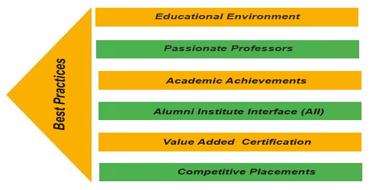
II. EXPLORING THE DIFFERENT WAYS TO IMPROVE THE EFFICIENCY OF ADMISSIONS
A. Sources of Information
Institutions publish a vast collection of information bulletin in the form of print as well as digital mode which can gain valuable insight. Visiting an institute website and reading informational brochures like admissions flyers, course overviews, placements literatures, faculty profiles, and annual magazines are the excellent resources for initial screening of the college.
B. Alumni Success Stories Play A Motivational Factor To A New Entrant
Maintaining good relationships with alumni over time is essential to the success of MBA colleges. Alumni can always act as admission ambassadors representing their alma maters. Involving alumni members in the institute best practices via, webinars, alumni talk series; career counselling, projects, recruitments etc, helps to get best students. Alumni can share their success stories and work experiences, which will motivate new aspirants, through positive posts on digital platforms create increase in the application rates.
C. Hosting Crash course on Quantitative Aptitude and Logical Reasoning
Conducting one week free online / offline aptitude test - Quantitative Aptitude, Logical Reasoning, Data Interpretation, Verbal and more will help the prospective students who wish to appear for the Post Graduate Common Entrance Test (PGCET) and Karnataka Management Aptitude Test (KMAT) to understand their strengths as well as point of improvements. The facilitator identifies the aspirant’s areas of weakness. After the completion of the one-week course, a Mock test will be conducted so that student is completely ready to crack the real test!
D. Creating Prerequisite of Unique Selling Proposition
Admissions to best MBA college is very competitive, many of the applicants can have a better academic record than others, college needs to figure its unique selling proposition model and highlight it in front of the admission committee. College can consider some of these USP’s in their academic programs like Outbound Learning Activities, Professional Certification Programs, Scholarships, Career Focus Initiatives, Corporate Talk Series in different Functional Areas and Industry Learning Activities, etc.
E. Impact of Digital Reaches
Social media plays a very important role in the student’s transformative learning process. The sourced Information can be communicated with friends, classmates easily through the present emerging technological innovations. IT support academic learning materials like study materials, class notes, video lectures, case studies etc in the form of digital environment. Using social media provides a good sense of collaboration in the classroom while making better communication skills, knowledge sharing with students. Many MBA colleges have begun the facility of interconnecting with a large number of alumni students and present students through the means of social media networks, for example, Facebook, LinkedIn, Twitter, and YouTube. These social media pages can be utilized to communicate institute activities, Campus news, Academic Excellence, Placements, Newsletters and Institute publications, Corporate and Alumni talk series, and faculty blogs etc, with text and video format make declarations, and provide students with more valuable information. This updated posting vibe creates involvement between the institute and students, which help handle several admissions and placements related issues through the social media groups. Social Media is seen as a key support for their admissions. Many colleges have dedicated social media advertising campaigns.
F. Promotional Strategies: A one to one approach
Banner stands, flyers, newsletters, social media posts, print media advertisements etc, these all are great options for promoting admissions. The informative publications can be used to promote the college. On the other hand, the most influential faculty in degree colleges can be used as driving force for admissions. The admission team educate those faculties about MBA program and New Education Policy. Institutions may distribute the respective literatures to the aspirants with communicating a one to one approach on their MBA entrance exam. Many of the graduate faculty members should be given awareness about management education is regarded as the trendy course by the students from their perspective. This should be changed through proper awareness campaign, usually done through Faculty development Programs and workshops dedicated to degree faculty members. The myth of ‘MBA’ – a fancy course for rich people’ should be negated. The focus on the degree faculty members is because they stay with their students for three/four years and students regard them with high respect.
This has made degree faculty members opinion leaders and they will have the highest influencing authority in making their students chose the right higher education courses. This factor should be utilized by the management institutes and make them take right words on management course.
III. PROBLEM STATEMENT
The quickly increasing management education is a booming sector across the nation. India is a major player in management education and there are more than 10000 Higher Education Institutions in the management sector. The accelerated economical development witnessed significant status for MBA education.
The competition is high and to attract students for the MBA program, institution depend on different factors like, ancillary learning environment, competent faculty, comfortablea and capable learning centre, state-of-the-art computation centre, academic and career achievement, placement spotlight, management fests etc. Hence the research is to understand the best practices that attract students for MBA program.
IV. OBJECTIVES OF THE STUDY
- To understand knowledge sources of aspirants regarding MBA education that plays a major role in selected districts of North Karnataka.
- To identify the factors that influence in selecting the higher education course.
- To comprehend the motivating factors for applicants to study MBA.
- To know the statistically significant association between gender, place, graduation with respect to sources of information and motivating factor to join MBA
- To know the effectiveness of the factors influencing admissions.
V. RESEARCH METHODOLOGY
The study is based on primary research. The sample unit for the study are the students of North Karnataka region form 7 places i.e., Dharwad, Belagavi, Haveri, Uttara Kannada Gadag, Bagalkot and Bellari. The total sample size for the study is 125 numbers and close ended questionnaires was prepared. The analysis of the study was done by using MS Excel and SPSS and Chi-square test to study the relationship between gender , place and graduation with respect to sources of information and motivating factors influencing to join MBA and one-sample test is used to understand the effectiveness of the different factors influencing admission.
VI. ANALYSING AND INTERPRETING DATA
Table 1.1 showing the gender ratios of people taking the MBA entrance exam
|
Gender |
No |
% |
|
Male |
57 |
46% |
|
Female |
68 |
54% |
|
Total |
125 |
100% |
Figure 1.1 showing the gender ratios of people taking the MBA entrance exam is nearing parity (54 % Female/ 46 % Male).
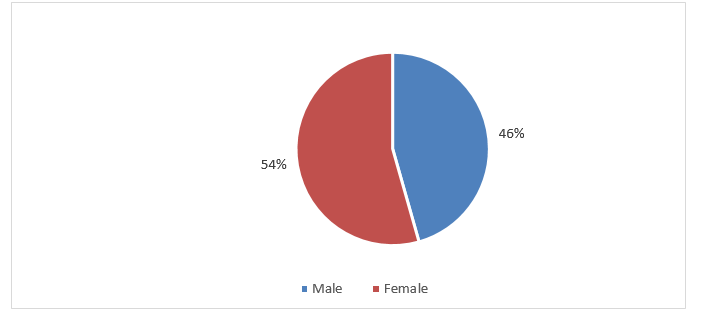
- Interpretation: Majority of the respondents are females as compared to males. It is due to the support of the parents they prefer to pursue higher education after graduation. Male respondents are confined to their home towns due to various reasons unwilling to relocate or are interested in start-ups.
Table 2.1 showing the undergraduate courses and applicant’s approaches
|
Graduation |
No’s |
Per |
|
BA |
15 |
12% |
|
B.com |
27 |
22% |
|
BSc |
19 |
15% |
|
BBA |
17 |
14% |
|
BE/B.Tech |
17 |
14% |
|
BCA |
19 |
15% |
|
Others |
11 |
9% |
|
Total |
125 |
100% |
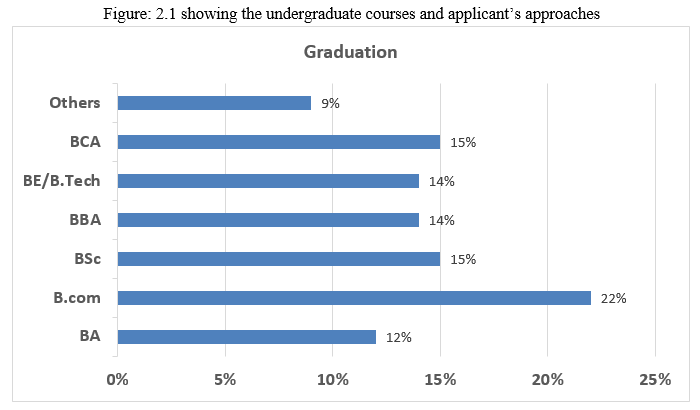
- Interpretation: Indian job market requires skill based and knowledge based work force. However, graduation is not sufficient to fetch good job as aspirants need specialized skills for a successful career. This is evident from the above graph that majority of commerce graduates are willing to pursue higher education, MBA in particular finance specialization. Equal number of aspirants are from science and computers areas wish to pursue higher education in marketing and human resource subject areas. This is becoming a trend wherein aspirants prefer to join MBA program to enhance their skills and knowledge.
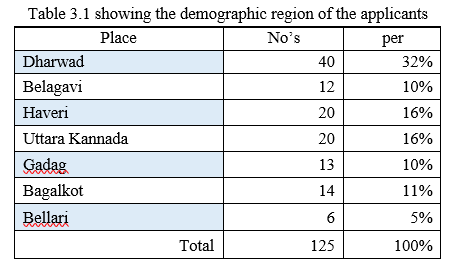
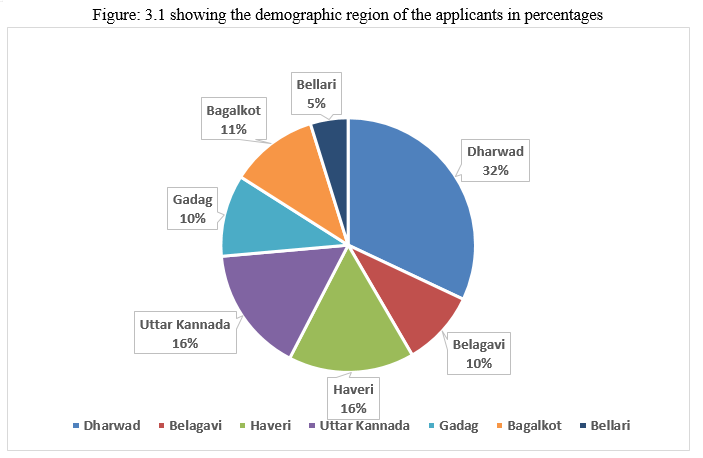
- Interpretation: From the above graph it is seen that majority of the aspirants hails from same town where Institution is placed or situated. Due to easy accessibility in terms of infrastructural facilities and has required facilities like location, ambience, medical facility and banks is the major reason to choose the right institution. Another important reason attributes to the increase in local students in MBA program due to academic excellence which Institute has built over the years. Remaining students from other locations are well versed with brand identity of the their college and their commitment to the field of higher education
Table 4.1 showing the effectiveness information sources of aspirants
|
Sources of Information |
No |
Per |
|
Print Media |
16 |
13% |
|
Social Media |
10 |
8% |
|
Website |
15 |
12% |
|
Friends |
26 |
21% |
|
Alumni |
19 |
15% |
|
Personal Visit to Campus |
39 |
31% |
|
Total |
125 |
100% |
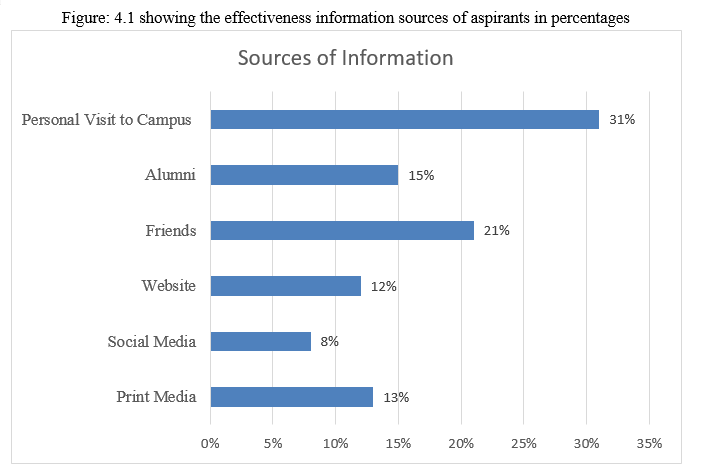
Interpretation: From the above graph it indicates that majority of the aspirants are influenced by their personal visit to campus during the time of before admissions. Many students comes with dilemma and come to conclusion to take admission attracted by the infrastructure and basic needs without checking academic environment. This may lead to wrong selection of college. In order to place right student, right college at the right time students required to compulsory make personal visit and get convinced with proper facilities being provide by the Institution.
Table 5.1: Influencing factors while selecting the higher education course
|
What influenced you the most in choosing the Higher education course? |
No’s |
Percentage |
|
Social Media |
57 |
15.6 |
|
Print media |
65 |
17.8 |
|
Website |
63 |
17.2 |
|
Alumni |
61 |
16.7 |
|
Friends and Family |
60 |
16.4 |
|
Personal Visit |
60 |
16.4 |
|
Total |
366 |
100 |
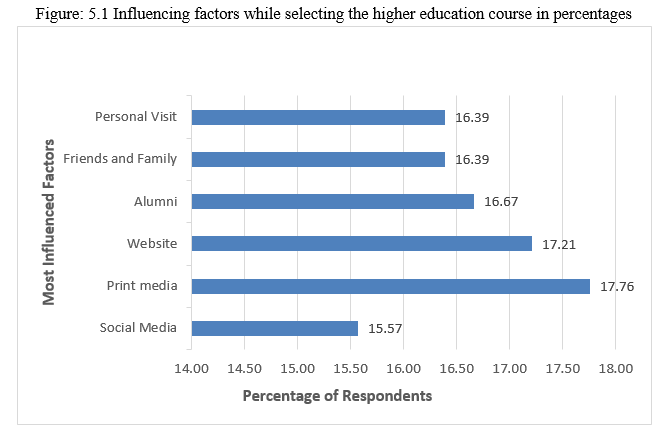
- Interpretation: As represented in Figure 5.1, the most influential factors from the above graph indicates that, aspirants interested to pursue higher education are influenced by print publications like brochures, holdings, newsletters, flyers and banners etc., being the most informative and attractive primary source to a prospective student. This will lead to a personal visit to the campus to understand better what is being advertised by the Institute in terms of academic achievements, experienced faculty and placements. They also get conversant with Social Media, Alumni, Friends and Family.
Table 6.1: Motivating factors for Applicants to Study an MBA
|
Most motivating factor to join MBA |
No’s |
Per |
|
Job Opportunities |
32 |
26% |
|
Faculty Recommendation |
18 |
14% |
|
Following the trend |
21 |
17% |
|
Value Addition course |
12 |
10% |
|
Higher salary |
26 |
21% |
|
Early promotion |
16 |
13% |
|
Total |
125 |
100% |
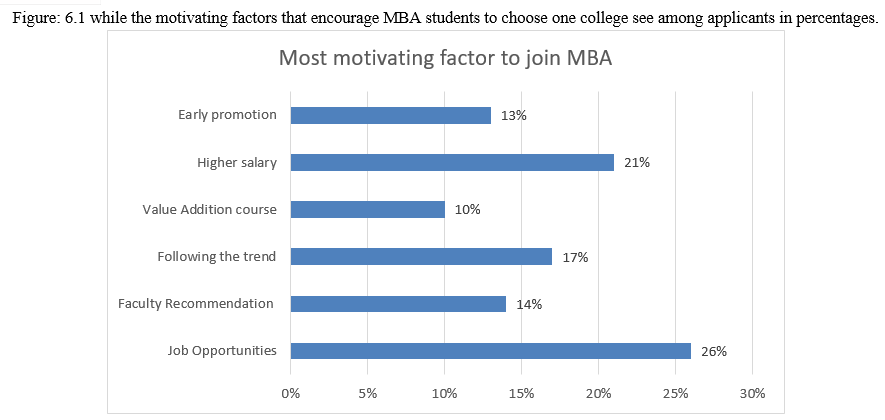
- Interpretation: From the above graph it is seen that majority of the graduates join MBA program due to various job opportunities available in the different streams and compared other professional courses. UGC approved MBA programs are under the affiliated universities committed to provide higher education with affordable fees and scholarships. This will enhance scope for many students, who are placed remotely in some parts of selected districts in Karnataka. Another reason for motivating prospective students to join MBA program is the higher salary in the initial days of career.
Table 7.1: Opinion on the effectiveness of various sources of information for MBA Admissions
|
Sources of Information |
Strongly Disagree |
Disagree |
Agree |
Strongly Agree |
|
Personal visit to the campus always helps in deciding |
21 |
38 |
24 |
18 |
|
Website content of the institute influences to an extent |
27 |
23 |
22 |
27 |
|
Campaigning during the PGCET exam influences to an extent |
21 |
34 |
23 |
24 |
|
Reviews from Alumni of the college influences to an extent |
27 |
25 |
27 |
23 |
|
Social media platforms helps to know about the culture in the institute |
30 |
27 |
20 |
19 |
|
Institute infrastructure influences to an extent |
24 |
22 |
22 |
30 |
|
Information booklets (brochures/Pamphlets etc) influences to an extent |
24 |
18 |
28 |
32 |
|
Currently studying students' review influences to an extent |
23 |
27 |
23 |
30 |
|
Faculty Academic Credentials influences to an extent |
24 |
27 |
30 |
17 |

- Interpretation: Information sources are essential to take decision on admission. Following sources of information influence to take admission. From above data it is clear most important factor influence to students is print publication of respective institutions are essential requirement for the admission process. The admission literature contains details about institution’s excellence achieved over the period and this factor become influencing parameters for the applicant. The second important factor as the most prominent in decision making is that the Institute infrastructure should be attractive and provide modern facilities with advanced class room set up, proper seating, teaching pedagogy materials, knowledge centre etc.. All these play a proactive role in selecting the Institute. This also evident from the fact that students who are currently pursuing their MBA program in the same campus would influence some extent by student level discussions held during the process of admission.
A. Hypotheses Statement
|
Sl. No |
Hypotheses Statement |
|
|
1 |
H1 |
There is statistically significant association between Gender and Sources of Information |
|
2 |
H1 |
There is statistically significant association between Place and Sources of Information |
|
3 |
H1 |
There is statistically significant association between Graduation and Sources of Information |
|
4 |
H1 |
There is statistically significant association between Gender and Motivating factor to join MBA |
|
5 |
H1 |
There is statistically significant association between Place and Motivating factor to join MBA |
|
6 |
H1 |
There is statistically significant association between Graduation and Motivating factor to join MBA |
|
7 |
H1 |
There is statistically significant influence of below factors on admission |
B. Statistical Analysis
Chi square Test
|
Sl.No |
Particulars |
Chi square value |
Degree of freedom |
P-Value |
Inference
|
|
Sources of Information |
|||||
|
1 |
Gender |
7.373 |
5 |
.194 |
NS |
|
2 |
Place |
21.216 |
30 |
.879 |
NS |
|
3 |
Graduation |
26.035 |
30 |
.673 |
NS |
|
Motivating factor to join MBA |
|||||
|
|
|
|
|
|
|
|
1 |
Gender |
6.369 |
5 |
.272 |
NS |
|
2 |
Place |
25.412 |
30 |
.705 |
NS |
|
3 |
Graduation |
30.731 |
30 |
.429 |
NS |
NS- Not Significant
VII. SOURCES OF INFORMATION
A. Gender
There is insignificant association at 5% significance level between Gender and Sources of information (?2 =7.373,df=5,p=.194) as p value=.194 >∝ = .05, Therefore we accept the null hypothesis and we conclude that there is no statistically significant association between gender and sources of information about the college.
B. Place
There is no statistically significant association at 5% significance level between Place and Sources of information (?2 =21.216 ,df=30,p=.879) as p value=.879 >∝ = .05, Therefore we accept the null hypothesis and we conclude that there is no statistically significant association between place and sources of information about the college.
C. Graduation
We accept the null hypothesis at 5% level of significance as (?2 =26.035, df=30,p=.673) as p value=.673 >∝ = .05, ie ,there is no statistically significant association between graduation and sources of information about the college.
Motivating factor to join MBA
- Gender: There is insignificant association at 5% significance level between Gender and Motivating factor to join MBA (?2 =6.369, df=5,p=.272) as p value=.272 >∝ = .05, Therefore we accept the null hypothesis and we conclude that there is no statistically significant association between graduation and sources of information about the college.
- Place: There is no statistically significant association at 5% significance level between Place and Motivating factor to join MBA (?2 =25.412, df=30,p=.705) as p value=.705 >∝ = .05, Therefore we accept the null hypothesis and we conclude that there is no statistically significant association between graduation and motivating factor to join MBA
- Graduation: We accept the null hypothesis at 5% level of significance between graduation and Motivating factor to join MBA as (?2 =30.731, df=30,p=.429) as p value=.429 >∝ = .05. ie ,there is no statistically significant association between graduation and Motivating factor to join MBA.
VIII. FACTORS INFLUENCING ADMISSIONS
One Sample T Test
|
Sl.No |
Particulars |
T Value |
P Value |
Inference |
|
1 |
Personal visit to the campus always helps in deciding |
24.125 |
.000 |
S |
|
2 |
Website content of the college influences to an extent |
23.058 |
.000 |
S |
|
3 |
Campaigning during the PGCET exam influences to an extent |
23.948 |
.000 |
S |
|
4 |
Reviews from Alumni of the college influences to an extent |
23.165 |
.000 |
S |
|
5 |
Social media platforms help to know about the culture in the college |
22.419 |
.000 |
S |
|
6 |
College infrastructure influences to an extent |
23.958 |
.000 |
S |
|
7 |
Information booklets (brochures/Pamphlets etc) influences to an extent |
24.553 |
.000 |
S |
|
8 |
Currently studying students' review influences to an extent |
23.726 |
.000 |
S |
|
9 |
Faculty Academic Credentials influences to an extent |
24.441 |
.000 |
S |
Significant: As the p value of all the above factors is .000 which is lesser than 0.05 hence we accept that all above factors have influence on admission.
Conclusion
This paper has focused on a study investigating the use of blended approaches to improve admissions to MBA Program from an institutional perspective. Primary objective was to understand the strategic aspects of admissions in higher education. Use of digital platform to sensitize the prospective students has been success in admissions. Social medial played a pivotal role in educating aspirants to choose right institution for their career growth. Statistically it can be concluded that there is no statistically significant association of Gender, Place and graduation with respect to the sources of information about the institute for MBA aspirants, it was also found the association was statistically insignificant between gender, place and graduation, in regards to the motivating factors that influenced the applicants to join MBA. It was found that the factors took into consideration for the study that influence admission like personal visit to the campus, website content, campaigning during PGCET, review from alumni social media platform, college infrastructure, information booklets, current student reviews and faculty academic credentials had statistically significant effectiveness in influencing admissions. Marketing mix adoption would significantly boost student enrolment in private institutions in North Karnataka. It should be noted, however, that if there is a tremendous increase in student enrolment, the institute income base would also improve, thereby improving sustainability and quality assurance. Private institutions in North Karnataka should endeavour to recognize and adopt the perfect marketing mix that is relevant for enhancing their student’s enrolment.
References
[2] Tezc?, Erdo?an and Içen, Mustafa (2017), High School Students’ Social Media Usage Habits, Journal of Education and Practice, Vol.8, No.27 pp.99-108, ISSN 2222-288X (Online) [3] Owusu Boateng, Raymond and Amankwaa, Afua (2016), The Impact of Social Media on Student Academic Life in Higher, Global Journal of Human-social science: G Linguistics & Education, Vol. 16 No. 4 ISSN: Online ISSN: 2249-460x [4] Moody B, Michael (2020), Factors Influencing Students’ Choice of an Institution of Higher Education, Doctoral Dissertation the Graduate School of Clemson University All Dissertations. 2628. [5] National Association for College Admission Counselling NACAC (2018), Guide to the College Admission Process, Arlington, VA 22201 [6] Choudhury, Rahul Gupta,Sharma, Sonika (2015), Recent Trends and Performance Metrics Evaluation of MBA Students in Reputed Business Schools in India, IOSR Journal of Research & Method in Education (IOSR-JRME) Vol.5, No. 5 Ver. III (Sep. - Oct. 2015), PP 56-61, e-ISSN: 2320–7388 [7] Wertalik, Donna (2017) Social media and building a connected college, Cogent Business & Management,4:1, 1320836, DOI: 10.1080/23311975.2017.1320836 [8] Aghaee M.Naghmeh, (2010) Social Media Use in Academia, Campus Students Perceptions of How Using Social Media Supports Educational Learning, Thesis, Uppsala University [9] Tamahankar, Parag (2022) 7 ways to Increase College Admissions with inbound Marketing. Blog. https://blog.epravesh.com/7-ways-increase-college-admissions/ [10] Agarwal, Nidhi (2022) Admission strategy for schools to increase student enrolment, https://www.leadsquared.com/admission-strategy-for-schools/ [11] Lapinskaite, Martyna (2020) 3 Creative Ways to Attract Students to Your College, https://www.archeredu.com/hemj/3-ways-attract-prospective-students-to-college/ [12] Bishop, Rachel (2020) Why Alumni Are Important for Higher Ed Institutions, https://www.signalvine.com/alumni/why-alumni-are-important-for-higher-ed-institutions [13] Pathak,Ankita (2022) Role of Social Media in a Student’s Life, https://blog.madeeasy.in/role-social-media-students-life
Copyright
Copyright © 2022 Mr. Anand Ulaya, Dr. Pooja Ainapur, Prof. Shreevasta Gudi. This is an open access article distributed under the Creative Commons Attribution License, which permits unrestricted use, distribution, and reproduction in any medium, provided the original work is properly cited.

Download Paper
Paper Id : IJRASET43341
Publish Date : 2022-05-26
ISSN : 2321-9653
Publisher Name : IJRASET
DOI Link : Click Here
 Submit Paper Online
Submit Paper Online

